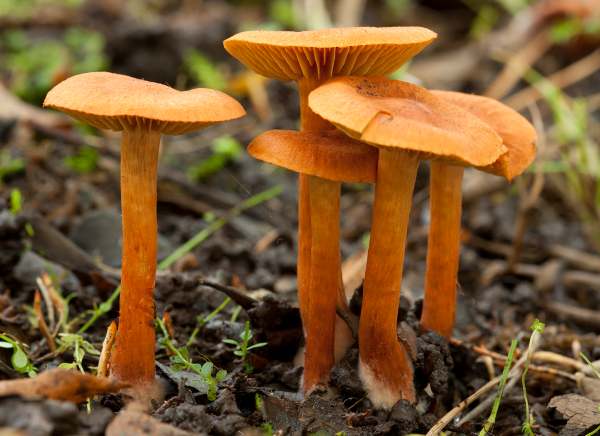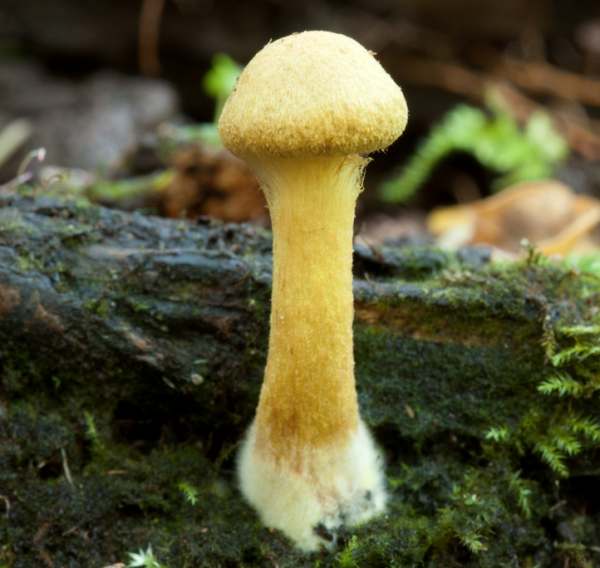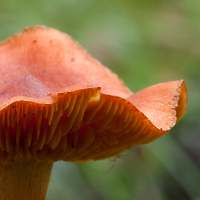Cortinarius uliginosus Berk. - Marsh Webcap
Phylum: Basidiomycota - Class: Agaricomycetes - Order: Agaricales - Family: Cortinariaceae
Distribution - Taxonomic History - Etymology - Toxicity - Identification - Reference Sources

Reddish webcap mushrooms are difficult to identify from their macroscopic characters alone, but the habitat in which the Marsh Webcap appears is a great help, as only a minority of mushrooms cope with very wet soil conditions.
Distribution
Scarce in Britain, the Marsh Webcap is recorded from England, Wales, Scotland and Ireland; it also occurs in many parts of northern and central Europe but rarely in Mediterranean countries.

Taxonomic history
This webcap was described in 1860 by British mycologist Miles Joseph Berkeley, who gave it the scientific binomial name Cortinarius uliginosus by which it is generally referred to today.
Synonyms of Cortinarius uliginosus include Cortinarius queletii Bataille, Cortinarius concinnus P. Karst., and Dermocybe uliginosa (Berk.) M.M. Moser, Schweiz.
Etymology
The generic name Cortinarius is a reference to the partial veil or cortina (meaning a curtain) that covers the gills when caps are immature. In the genus Cortinarius most species produce partial veils in the form of a fine web of radial fibres connecting the stem to the rim of the cap rather than a solid membrane.
The specific epithet uliginosus, which comes from Latin, means 'of marshes or bogs' and is a reference to the usual growing habitat of this webcap mushroom.
Toxicity
This mushroom is a member of the subgenus Dermocybe, which includes several deadly poisonous webcaps. It should be regarded as 'suspect' and may contain dangerous toxins, and so it should not be gathered for eating. Some reddish Cortinarius species with which the Marsh Webcap could be confused contain the toxin orellanine, which if eaten destroys human kidneys and liver.
Identification guide
 |
CapYoung caps often start of conical, becoming umbonate-convex 1.5 to 5cm in diameter and often developing a wavy margin. Cap colour is variable but usually tawny orange, coppery orange or occasionally brick red with the margin slightly paler than the central region; it is covered in yellowish radial fibrils most noticeably near the margin. StemCylindrical, 2.5-6,5cm tall and 0.3-1cm in diameter, occasionally with a slightly swollen base; surface longitudinally fibrillose and coloured as the cap; flesh yellow with a reddish tinge. |
 |
GillsThe adnate gills are close; initially bright lemon-yellow, tuning saffron to ochre-buff or tawny-buff. |
SporesEllipsoidal, with a finely roughened surface, 8-11 x 5-6µm; inamyloid. Spore printRusty brown. |
|
Odour/taste |
Odour, when cut or crushed, of radish. Tasting this possibly toxic toadstool is inadvisable. |
Habitat & Ecological role |
Ectomycorrhizal, in damp soil with deciduous woods, usually in willow or alder carr woodland. In northern Europe this webcap is found most often with willows beside lakes, rivers, bogs and marshes. |
Season |
August to November in Britain and Ireland. |
Similar species |
Cortinarius sanguineus, the Bloodred Webcap, has a blood-red cap and blood-red gills and stem. Cortinarius semisanguineus, the Surprise Webcap, has blood-red gills but otherwise it is similar macroscopically to the Marsh Webcap.. |
Reference Sources
Fascinated by Fungi, 2nd Edition, Pat O'Reilly 2016, reprinted by Coch-y-bonddu Books in 2022.
Funga Nordica, Henning Knudsen and Jan Vesterholt, 2008.
Fungi of Switzerland Agarics, part 3: Cortinariaceae, Breitenbach, J., Kränzlin, F.
British Mycological Society, English Names for Fungi
Dictionary of the Fungi; Paul M. Kirk, Paul F. Cannon, David W. Minter and J. A. Stalpers; CABI, 2008
Taxonomic history and synonym information on these pages is drawn from many sources but in particular from the British Mycological Society's GB Checklist of Fungi.
Acknowledgements
This page includes pictures kindly contributed by David Kelly.
Fascinated by Fungi. Back by popular demand, Pat O'Reilly's best-selling 450-page hardback book is available now. The latest second edition was republished with a sparkling new cover design in September 2022 by Coch-y-Bonddu Books. Full details and copies are available from the publisher's online bookshop...

